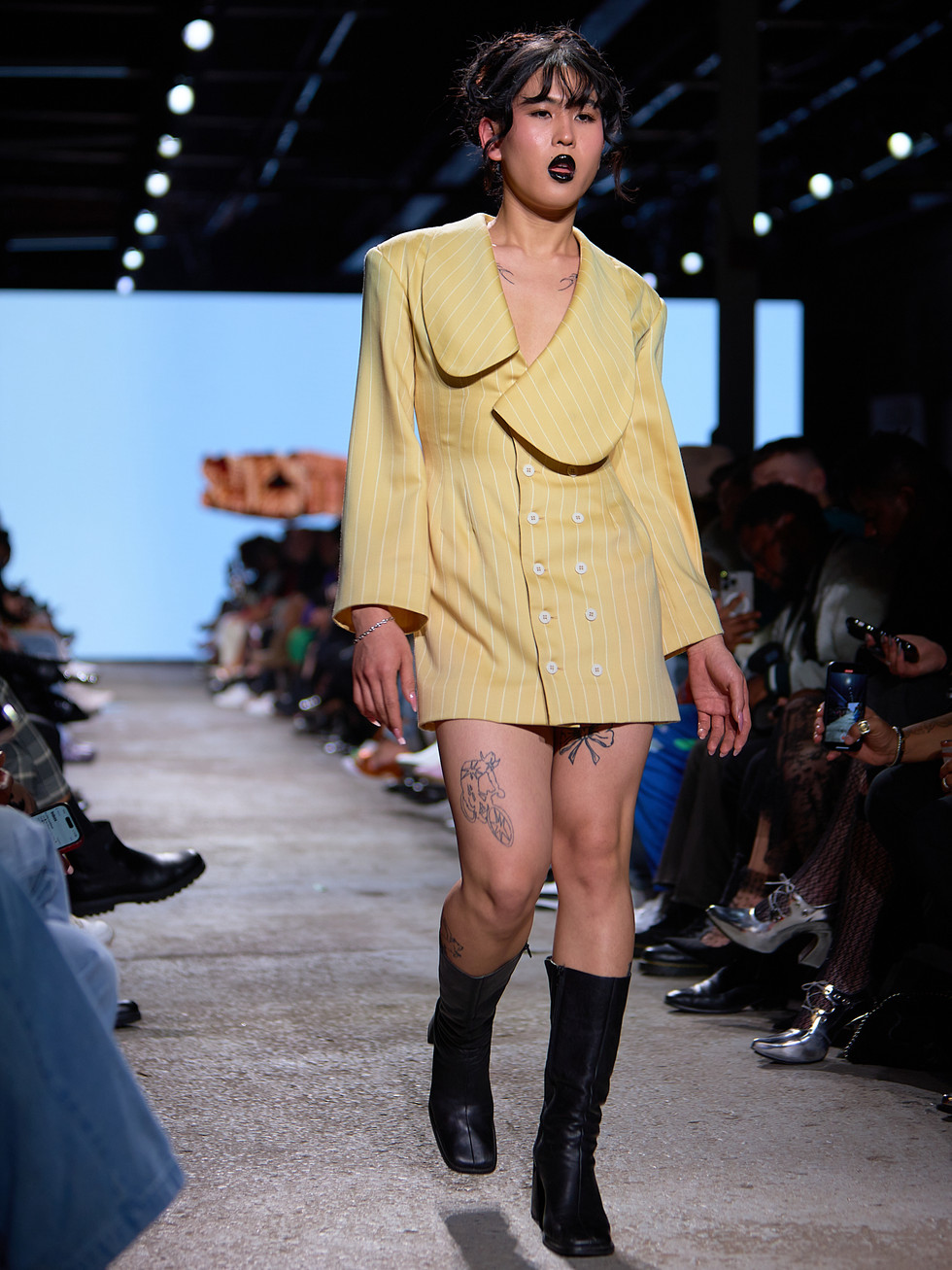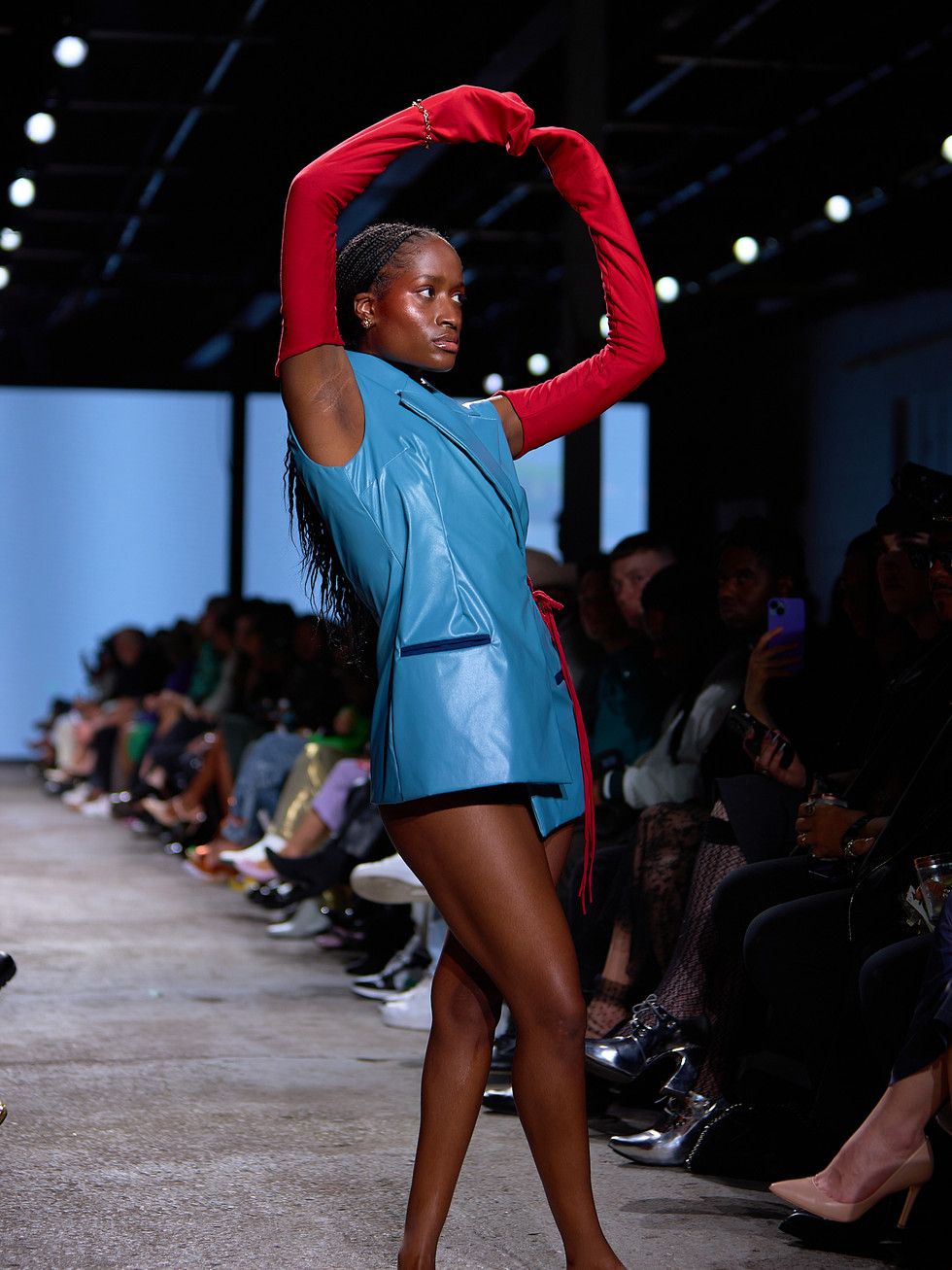Official FAT Recap - Day 2 SS24
- Astrid Superstar
- May 27, 2024
- 11 min read
Updated: Jun 28, 2024
Fashion Art Toronto’s 1664 Fashion Week returned to the Black Creek Assembly on Friday, May 3rd for their second round of the SS24 season’s shows. While opening night may be an opportunity to set the tone for fashion week, the weekend shows (especially the often-packed Friday and Saturday) are just as important. Fashion enthusiasts from around the city (and sometimes the country) punch out the clock on their 9-to-5’s, return home to transform into their show-stopping best and hit the runway room - keen to purvey the shows, rub elbows with industry denizens, and pose for pictures from the event’s many talented photographers.
DANI DOUCETTE
To kick off Day 2, opening show guests were treated to a high-energy performance of Dani Doucette’s latest single “Femininergy”. The room was flooded with red as the beat dropped, and Doucette emerged from backstage accompanied by 4 dancers. Each had their long hair let loose, gyrating in barely-there black bikinis, accessorized with undone garters or rhinestone mesh.
Dani Doucette performing "Feminenergy". Fashion Art Toronto's 1664 Fashion Week SS24.
Photos by Jack Hathaway with @picjerphoto.
Doucette herself wore a shiny pleather bodysuit, her thigh-high stiletto boots reflecting the overhead lights. A hot-pink harness by Virtue & Valour added a touch of empowering eroticism, a perfect match for the song’s liberating lyrics.
STACEY MITCHELL DESIGNS
Stacey Mitchell Designs’ “Traditionally Modern” was a celebration of the beauty of Indigenous design and culture. Mitchell promised to explore the combination of contemporary clothing with traditional Indigenous elements, to “allow people to showcase their Indigenous pride”.
Set to inspiring R&B tracks (“Finesse” by Bruno Mars, Stephanie Mills’ “Never Knew Love Like This Before”, etc.), the collection was a fun and upbeat exploration of identity. Mitchell effectively subverts colonial norms by infusing Western styles with traditional approaches to fashion.
Perhaps the most significant manifestation of this idea found within the show was a dress that featured a print of Dave Fadden’s painting Girl With The Wampum Earring. The painting is an ironic parody of Johannes Vermeer’s famous Girl with a Pearl Earring, with Fadden’s rendition celebrating Indigenous features while simultaneously critiquing the appropriation and erasure of the culture.
Mitchell redefines gender roles by taking masculine clothing items - such as blazers - and combining them with feminine elements - like long trains and floral prints. Earth-tone garments were adorned with brightly coloured detailings and patterns in creams, deep purples, royal blues and shades of tan. We saw the incorporation of animal hides as fringe or a shoulder cape, or peeking out of the opening models’ woven basket.
Creative Hair and Makeup Directors Dylan Cruikshank and Jez Taylor, respectively, knocked it out of the park with the collection’s execution. Hair was braided tight or loose, depending on the look, and makeup was a natural, soft glam. The incorporation of jewelry, ranging from subtle to statement was a perfect finishing touch. Shoulder-dusting earrings often settled on models’ collarbones, featuring Indigenous floral motifs, while large necklaces of turquoise or silver naturally completed the looks.
"Traditionally Modern", Stacey Mitchell Designs. Fashion Art Toronto's 1664 Fashion Week SS24.
Photography by Matt Reid.
Another highlight of “Traditionally Modern” was a grand, oversized black hat, worn by a model to complement an elegant floral-print dress. Beaded fringe was attached to the edges, dusting the floor with the models’ lithe movements. The width of the hat must have taken up the entire runway, shimmering strings invoking the appearance of falling rain.
One of the many aspects that sets Fashion Art Toronto apart from the other major fashion weeks - everybody loves when they can tell that the models are having fun. For the closing look, FAT veteran Mashawi broke out into a little groove to Montell Williams’ “This is How We Do It”. Using playfulness and exaggeration, Mitchell makes the audience feel welcome into the world she has created.
SIYAWAREVA
The following show by Siyawareva, with jewelry provided by Famluxy, poignantly captured the essence of hazy summer adventures. African designer Foster Siyawareva’s “Spirit in Motion” was directly inspired by the Dinka tribe of Sudan, who are often referred to as the Jieng people.
The Dinka are the largest ethnic group in South Sudan, with subgroups numbering about a million people, according to The Guardian. A collection of photos they published in 2017 gives us an authentic glimpse into the lives of the group. We see a culture of deep association with nature and animal - specifically the cow - which they rely on “not purely for economic reasons, but also cultural expression”. A post on the Cultural Diversity Resources blog spotlights the fashion of the South Sudanese, emphasizing a conglomeration of bold prints and bright patterns.
Half the world away, models took the catwalk against a digital backdrop of the setting sun’s final moments. The first look presented - a denim suit, complimented by geometric jewels, suitable for both casual and formal occasions. FAT designer (and frequently featured model) Hyla strutted down the runway, wearing the power-suit with the confidence it required.
Chic garments were often monochromatic, focusing on a single colour, each perhaps capturing a close-up of a broader, more intricate African pattern. The concept of versatility was present within the collection, along with an appreciation for the colours and textures found within nature. We see beadwork and feathering in earrings or woven into models’ hair. Leather pieces take on the essence of solid mountains, tall and proud, yet maintain a distinctly feminine energy through how they perfectly hug the wearer’s body.
"Spirit in Motion", Siyawareva. Fashion Art Toronto's 1664 Fashion Week SS24.
Photography by Matt Reid.
Famluxy’s jewels highlighted the colourfulness and eccentricity of flowers in the form of rings and brooches. Notably, this was Famluxy’s second out of three collaborations with designers this seasosn (the first being opening night’s Kyle Gervacy, with the latter as Day 4’s Meglio & Meglio).
Siyawareva’s manipulation of vinyl with pleating, and embracing their properties, led us into the final look. A stunning silver gown, with a matching hooded veil, replicated the ripples of water - displaying Siyawareva’s masterful understanding of their own craft.
CAFFERY VANHORNE
Caffery Vanhorne’s collection brought out the breezy sexiness that we all think of when envisioning life in warmer climates. Made up of light cotton, silk meshes and geometric prints, the summer sensuality of the show was undeniable.
The fast-paced runway, set to cheery Latin-influenced bops, featured comfortable and classy resortwear with a relaxed vibe - think slides and sandals. Recurring low-cut bikini bottoms emphasised models’ stunning physiques. Even pieces that did cover the body more remained light and see-through. Some looks were fitted with woven belts to emphasize the tropical aesthetic. While black and white prints were certainly the focus of the collection, strong hues of blues and greens would occasionally make an appearance.
Despite the collection focusing heavily on menswear, feminine elements such as lacing and long summer dresses were sprinkled throughout. A selection beach bags were additionally showcased within the show, with matching prints to the outfits - duffels slung casually over one shoulder, crossbody styles and satchels. The addition of these accessories, including demonstrating Vanhorne’s dedication to creating a collection with everything one could need on a sunny vacation.
Caffery Vanhorne SS24 collection. Fashion Art Toronto's 1664 Fashion Week SS24.
Photography by Matt Reid.
In what must have been quite the feat for the dressers backstage, the models went around twice - some even three times - requiring multiple quick-changes. Thankfully, Lead Dresser duo Anmol Handa and Wares Popalzai run a tight ship, and the transitions went off without a hitch. For the audience, it was near impossible not to fantasise about lounging lazily on a tropical beach, wearing Vanhorne’s seductively bold beachwear.
BLACK DESIGNERS OF CANADA
Fashion Art Toronto and the Black Designers of Canada organization have enjoyed a close partnership for multiple seasons. In order to bolster and spotlight the talent of local Black-owned labels, FAT has provided the opportunity for many of these brands to present during Fashion Week - in shows completely sponsored by FAT itself. For this season, 3 designers received this coveted opportunity - Soap Studios, Mufaro Mukoki and Vibe the People.
RONEY X
To begin, Afro-Caribbean dance artist Roney X set the scene with a show-stopping performance to a fully packed house. Strobe lights flickered and intense bass vibrations filled the audience's chests as they cheered in anticipation.
Roney X performing at Fashion Art Toronto's 1664 Fashion Week SS24.
Photos by Jack Hathaway with @picjerphoto.
The video for his single “Come Thru”, a grainy VHS-style film of the singer himself, filled the massive screen at the end of the runway. Roney X is surrounded by dancers as he takes the stage, who managed to do an impressive switchover to a new set during the songs’ transition. The first group is dressed entirely in denim jumpsuits, whereas the second had high heeled boots and short skirts. Dancers vogued down the runway, eliciting woops from the crowd.
SOAP STUDIOS
SOAP Studios is a fashion label that honours femininity, and their collection “Arriving” perfectly embodied this aspect of the brand’s ethos. Designer Cleo Savonne Williams describes “Arriving” as “a celebration of stepping into yourself … a colourful resort collection that asks the wearer to bring the inside out. Structured organza pieces with exposed pockets, plunging necklines and flattering bias skirts unite in a divine feminine ready-to-wear collection.”
The show blended masculine symbols of power, such as blazers and suit vests, with iconic feminine imagery like frills, high waisted pencil skirts, and colourful fabrics. While most of the collection would be pastel shades or stark white, garments of a strong bright green were sprinkled throughout. We did see much of the promised structure, accentuated with soft, rounded edges.
The makeup was mostly natural with a distinct “doll eye” look - aside from the lipstick, which stood out as a strong black shade. The shine from the glossy lips matched the reflection of the onyx-toned boots and Mary Janes on the models’ feet, often paired with white bobby socks. Hair was piled high, with braided twists curling onto the head or framing the face. The juxtaposition of the flirtatious fabrics and grungy makeup gave an interesting parallel of innocent and bold.
SOAP continued to explore female strength outside of office wear as well. While many think of babydoll dresses and frivolous and girlish, they were actually a sign of liberation in the 1940s when designer Sylvia Pedlar reduced the length of her nightgowns due to fabric shortages of the time. Previously, corsets and heavily structured gowns were standard everyday dress, so being able to wear something so light felt freeing to most women.
"Arriving", Soap Studios. Fashion Art Toronto's 1664 Fashion Week SS24.
Photography by Matt Reid.
The bullet bra, which makes an unmistakable appearance in the collection, is also an important garment in the context of women's emancipation. Instead of concealing and hiding the female body, the bullet bra caricatured it, effectively reducing taboos regarding breasts. The rose pink colour and stripes on SOAP’s rendition are also most likely a nod at Jean-Paul Gauthier’s take on the bullet bra for Madonna’s Blond Ambition tour, which revived the style back in the ‘90s.
SOAP effortlessly manages to merge the masculine and the feminine - as well as the historical and modern - elements of fashion, resulting in a line that anyone is bound to feel confident in.
MUFARO MUKOKI
Mufaro Mukoki’s collection “Breathers” was undoubtedly one of the most open and vulnerable runways of the season. “Breathers aims to inspire empathy in both wearers and audiences,” said Mukoki. “In the last year, I undertook research into the experiences of African immigrants and how these could be expressed through fashion design to inspire collective thought. The collection builds on the knowledge gained through this experience. Lying somewhere between commercial fashion and critical design, the designs embody the complex identities we build through our histories and lived experiences.”
Prior to the show starting, a video played on the big screen of two people clinging onto each other. Mukoki’s voice accompanies the short film, explaining that she wanted to translate the “immigrant experience” - to put the viewer in someone else’s shoes. “Clothing is personal,” she firmly states.
The music was tense and disconcerting, comprising dissonant tones and choir-like vocals with harsh strings. The horror-movie vibes that the sounds invoked had the audience on the edge of their seats. Suddenly, the show’s opener Angelica walked out in a bright blue suit that led into half-cut pants. Barefoot, their movements were slow and calculated, as they followed the disjointed beat.
From the get-go, it was clear that the message of the show went beyond the typical . Blue garments were perfectly moulded to the wearers’ bodies, almost disturbingly-so. All of the models seemed hindered in some way, creating a distinct air of vulnerability. As the show went on garments became more and more restricting, with sleeves sewn to the waists of dresses and bracelets directly attached to their hems. One models’ long gloves ended in mittens, anothers’ arms are forced to her side by her dress itself.
"Breathers", Mufaro Mukoki. Fashion Art Toronto's 1664 Fashion Week SS24.
Photography by Matt Reid.
Red string, woven around waists, dangled to their bare feet. Perhaps most captivating was an organic, burgundy shape protruding from chests and stomachs. An open wound, still fresh and pulsating, bare for the world to see.
The message to the audience was clear - Mukoki is translating the feeling of isolation and a lack of freedom that people may feel when they are thrust into a completely new world, especially forcefully and without choice. “Breathers” was a beautiful and touching, albeit somber, display of expression.
VIBE THE PEOPLE
Closing out Day 2 was VIBE THE PEOPLE, a vibrant streetwear brand by designer Ruby Bagaya. “'Zebra News' is a collection where Afro-futurism and Afro-punk converge in a celebration of community and individuality,” she writes of her collection. “Drawing inspiration from the iconic zebra, this collection intertwines the animal's distinctive stripes with the narrative of text and storytelling. Each garment embodies the spirit of the zebra, showcasing a fusion of fur, textiles, and visual imagery of the human form; all enhanced by dynamic Y2K and 3D elements.”
“This collection invites viewers to embrace their uniqueness while honoring the strength of unity,” she continues. “Step into a world where fashion becomes a canvas for self-expression and every ensemble tells its own vibrant story.”
Combining streetwear and Sci-Fi, the show was loud and proud, beginning with the dance-pop classic “Heads Will Roll” by the Yeah Yeah Yeahs. The ensuing music was equally hyped and the models were swift, direct, and confident. It featured subversive styles, graphic “VIBE THE PEOPLE” prints, and a large range of textures.
From the abundance of hair gel, the Bowie-esque silver makeup, and the DIY essence of the collection, it was hard not to pick up on the overt punk-rock influences. Printed ski masks and torn garments were slightly more obvious nods to the movement, but the looks that truly stood out were those that utilised fabric scraps and blankets - a practice more true and authentic to the essence of punk. One model wore a mini-skirt and top set made from used fabrics, complete with massive matching butterfly wings. Another featured what looked like 100 “Vibe The People” clothing tags safety- pinned to their outfit.
Spikes, chains and big leather boots contributed to the sexy, grungy aesthetic. Lips were black or silver - sometimes both - and hair featured many traditional Black styles like fro’s, locs and bandu knots. The hairstyles were filled with accessories - silver clips, barrettes, rings and chains.
"Zebra News", Vibe the People. Fashion Art Toronto's 1664 Fashion Week SS24.
Photography by Matt Reid.
The finale piece was the star of the show - a mini skirt and bikini top set made from a soft, vibrant blanket printed with VIBE THE PEOPLE’s logo. The model wore a watching ski mask with bunny ears that were as long as their entire body, spinning them playfully around as they stomped down the runway. A stuffed zebra toy, a direct nod to the collection’s theme, also made an adorable appearance.
Despite the comforting nature of the fabric used to create the ensemble, it remained edgy and distinctly VIBE THE PEOPLE. The brand’s principals rely on going against the grain and re-contextualization.
--
Day 2 was a perfect encapsulation of what Fashion Art Toronto is all about. Performances were exciting and lively, and the runways ran the gamut of the human experience. From celebrating joy, and even reflecting on our world, the audience left feeling invigorated and inspired. Join us next week for our recap on Day 3 - which featured some of the season’s most highly-anticipated runways.



























































































































































































































